Abstract
The increasing application of nutrition in cancer management has attracted a great deal of research interest in recent decades. Nutritional therapies, interventions, and assessments were known to have positive effects on reducing side effects from cancer therapy. In order to identify the global research output for nutrition in cancer research, a bibliometric analysis during the past 10 years was conducted to evaluate the current status of trends, gaps, and research directions as no bibliometric studies have been conducted regarding nutrition and cancer. After the data collection, a total of 1521 articles were chosen for this bibliometric study. The visualization analysis was performed with VOSviewer. The number of publications has grown continuously since a substantial spark was identified in 2019. The majority of the authors’ affiliations were in European countries. Four cancer types were recognized among the top 10 author keywords; they were breast cancer, head and neck cancer, colorectal cancer, and gastric cancer. The Nutrients journal was the most popular among the authors as the journal published 195 articles related to the topic. In conclusion, providing evidence-based nutritional solutions for various types of cancer is essential to nutrition and cancer research. Since it is presumed to have a growing number of cancer patients worldwide with the aging population, it is vital to continuously generate research finding effective nutrition therapies for cancer patients.
1. Introduction
Nutrition therapy is a nutritional-based treatment, including identifying a person’s nutritional status and giving the right foods or nutrients to treat various diseases such as cancer, diabetes, and metabolic syndrome. Numerous studies reported that deficiency of certain nutrients proceeds brain dysfunction; moreover, poor nutritional status is associated with the prevalence of pre-metabolic syndrome, hospital stay, and the life expectancy of diabetes patients [1,2,3,4]. Based on the research, the supply of appropriate nutrients is vitally essential to curing and managing various diseases.
Cancer is a complex disease characterized by the uncontrolled growth of abnormal cells. The effect of malnutrition on health and cost factors in cancer patients has been shown in several studies; especially, cancer patients with malnutrition conditions showed poor outcomes, higher medical costs, and low quality of life [5,6,7]. With the increasing evidence, nutrition therapies, interventions, and assessments have shown its positive effects for managing various cancer types. For instance, studies have shown that the use of nutrition therapy results in better outcomes for patients with head and neck cancer, colorectal cancer, and pancreatic cancer [8,9,10].
Malnutrition is frequent in cancer patients, and the risk is higher in older patients or those treated with chemotherapy [11,12]. Aging is one of the most important risk factors for cancer. The rapid growth of the aging population is expected as the number of people with cancer aged 80 or older is expected to triple by 2050 [13]. More importantly, in older patients with cancer, malnourished patients had higher mortality rates than those who were well-nourished. Additionally, the elderly patients are particularly vulnerable to the impact of malnutrition caused by age-related changes and cancer-induced factors [14]. Thus, an early assessment of malnourishment is critical for selecting personalized nutritional interventions while preventing sudden nutritional deterioration [15].
Chemotherapy and radiotherapy are known as the elementary tumor therapeutic strategies used in most cancer cases. However, chemotherapy and radiotherapy often cause various side effects, which are highly susceptible to a malnourished status. Commonly reported side effects from cancer therapies include a decreased appetite, weight loss, fatigue, hair loss, nausea, and vomiting [16,17]. It is noteworthy that the recent research has outlined a positive role of nutritional therapy against side effects of cancer patients receiving chemo- and radiotherapy [18,19].
In the past, there was a lack of awareness of the clinical benefits and authoritative guidelines of nutritional therapy in cancer treatment due to insufficient evidence-based research on this topic. However, there have been outstanding efforts to promote nutrition for cancer patients. A guideline for nutrition in cancer patients was introduced on a continental level; the evidence-based guidelines were developed by ESPEN by the European Partnership for Action Against Cancer as an EU-level initiative [20]. A comprehensive review indicated that the nutritional guidelines had shown positive results of a decrease in various types of cancer risks [21].
Despite the significant interest in utilizing nutrition methodologies for cancer, there has not been enough scientific evidence to give more options for healthcare professionals to consider nutritional interventions [22]. Therefore, a bibliometric study of the global trend of nutrition-cancer research was considered.
As no bibliometric studies have been conducted to seek the global trends regarding nutrition and cancer, a bibliometric study was carried out over the past 10 years. This bibliometric analysis is essential to evaluate trends, gaps, and research directions in the area of interest; in addition, it is exceptionally effective in grasping the overall trend of the research activity [23]. Hence, the aim of the study was to perform a bibliometric analysis to explore the current status of research on nutrition and cancer from 2011 to 2021 to global research productivity, promoting future research priorities. In particular, the analysis followed the dimensions: (i) number of publication/years; (ii) authors; (iii) affiliations; (iv) author keywords; (v) journals; (vi) most cited publications; (vii) collaboration among countries.
2. Materials and Methods
A bibliometric analysis, a valuable tool for navigation in a particular research area, was conducted to identify key trends and patterns in the field of scientific data by applying mathematical and statistical methods to analyze the course of publications [24,25].
2.1. Data Source and Search Strategy
For bibliometric and visualization analysis, the metadata from the SCOPUS database were retrieved on 17 January 2022, to conduct analysis. The SCOPUS database was chosen because it is one of the largest databases for finding quality global journals [26]. Additionally, the SCOPUS database covers a broader range of topics than other indexes; it is more accessible to the public, allowing free access to author and source information, including metrics [27].
The search terms, related to (1) nutrition and (2) cancer, were chosen based on preliminary search, looking at various systematic reviews for relevant keywords [28,29,30,31], discussions among authors and suggestions from physicians and nutritionists. A detailed search query was outlined in Box 1.
Box 1. The Search Query.
- (1)
- “nutrition” OR “nutritional therap*” OR “nutritional assessment” OR “nutritional supplement*” OR “nutritional intervention*”
- (2)
- “cancer” OR “cancer care” OR “tumor” OR “neoplasm*” OR “malignanc*” OR “oncology” OR “cancer patient*” OR “cancer management” OR “cancer prevention”
2.2. Data Collection
The study period was from 2011 to 2021. To raise the accuracy of finding the relevant studies, the search query was performed in the “title” section only. Based on the search strategy, a total of 2040 articles were identified during the initial search. Then, the articles were restricted to those that (1) were written in English, (2) were original and review articles regardless of the type of animal or human studies, and (3) were in the final publication and in press. Any non-peer reviewed articles were excluded as the results may not be evidence-based and fallacious [32]. A title-specific search was carried out to identify highly cited articles [33]. Additionally, only English language publications were considered, as previous bibliometric studies indicated that the original articles written in English were the majority of the assessed literature [34]. Therefore, a final set of 1521 articles were selected in the final analyses (Figure 1).
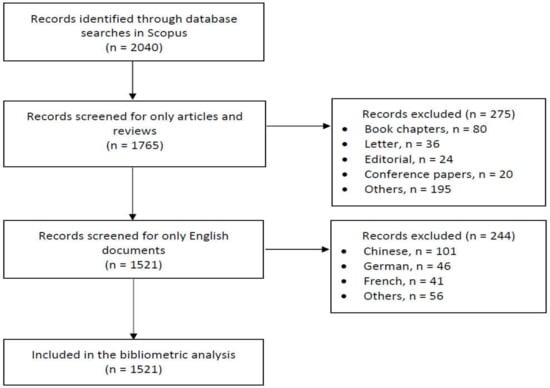
Figure 1.
Flow diagram for the bibliometric analysis.
2.3. Data Analysis and Visualization
The metadata was manually checked by two researchers (W.C., K.-R.B.) for any duplicates and errors, and then, imported to Rstudio v.4.0.2 software(R Studio, PBC, Boston, MA, USA) (22 June 2020) with the bibliometric R-package (http://www.bibliometrix.org) (accessed on 15 January 2022) was used to extract authors, author keywords, author collaboration in between countries, affiliated institutions, journals, citations, and countries; in addition, the word cloud and world map of collaborative authors were created with the Biblioshiny app from the bibliometric package [35]. Bibliometrix and biblioshiny are the open-source packages used in the R language environment. Bibliometrix is capable of the entire process of scientific data analysis, while biblioshiny enables users to create a visual analysis based on an interactive web interface [35]. The author keyword co-occurrences and cluster keywords were analyzed and visualized using the VOSviewer v.1.6.11 (Centre for Science and Technology Studies, Leiden University, Leiden, The Netherlands). The VOSviewer has been used in numerous previous bibliometric studies for creating co-occurrence matrix and identifying clusters from the keywords network [36,37]. The global trend of publications graph was created using Microsoft Excel 2020.
3. Results
3.1. The Global Publication Trend
The number of publications regarding nutrition and cancer has grown over a decade. The average growth rate was 10.03%, and the highest number of publications was in 2021 with a total of 268 articles. According to Figure 2, there was a substantial spark in publications since 2019 compared to any previous years.
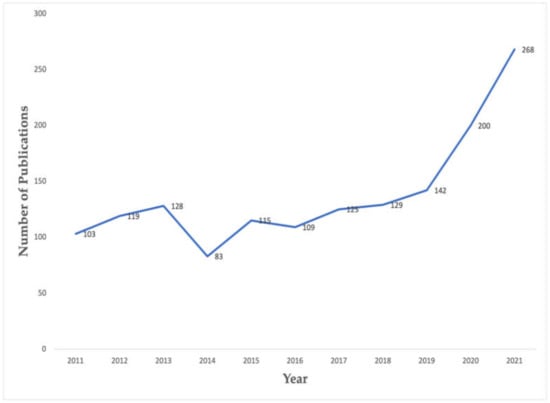
Figure 2.
The number of publications on nutrition and cancer from 2011 to 2021.
3.2. Authors, Author Keywords, Affiliations
Tumino has generated the highest number of articles (195 articles; 12.82% of the total number of articles) among the 7134 authors; the second highest was Trichopoulous (191, 12.56%; Table 1). With regard to the author affiliations, the top 10 list shows that the authors belonged to institutions in European countries (Table 2). Among the 10 author affiliations, three were in United Kingdom (Imperial College London—London, University of Oxford—Oxford, and University of Cambridge—Cambridge, England). The authors from the Imperial College London have published the highest number of articles so far (410 articles).

Table 1.
Top 10 most productive authors.

Table 2.
Top 10 most affiliation of the authors.
Of the 2398 author keywords, the top 10 keywords were identified in Table 3. The key word with the highest number of occurrences was nutrition (236 occurrences); the second highest was cancer (202 occurrences). Amid the list, four different types of cancer were found: breast cancer, head and neck cancer, colorectal cancer, and gastric cancer. Breast cancer had the highest occurrence among the cancer types with the 71 occurrences.

Table 3.
Top 10 list of the author keywords.
As Figure 3 illustrates, the author keywords were divided into four clusters with four different colors: red (cluster 1), green (cluster 2), blue (cluster 3), and yellow (cluster 4). The clusters are the indication of the major research directions; the size of the nodes indicates the frequency of occurrence. The curves between the nodes represent the co-occurrences in the same publication. The shorter the distance between the two nodes, the larger the number of co-occurrences of the two keywords.
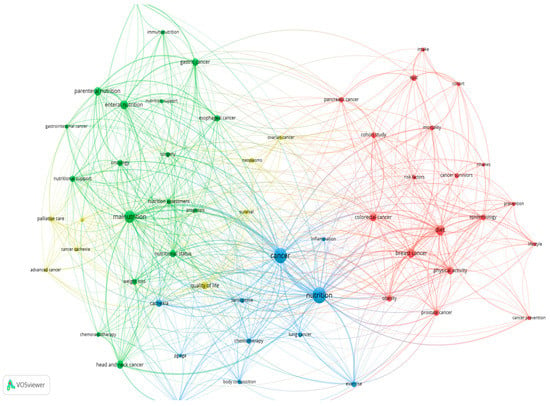
Figure 3.
A network map of the co-occurrence analysis of the author keywords.
In order to depict the frequency of author keywords, a word-cloud was created to find more relevant keywords besides the top 10 keywords (Figure 4). The font size represents the frequency of occurrence, and the important keywords apart from the top 10 list were found, such as lung cancer, sarcopenia, esophageal cancer, prostate, pancreatic cancer, etc. Based on the word-cloud, it can be presumed that the utilization of nutrition could be adapted to a wide array of types of cancer.
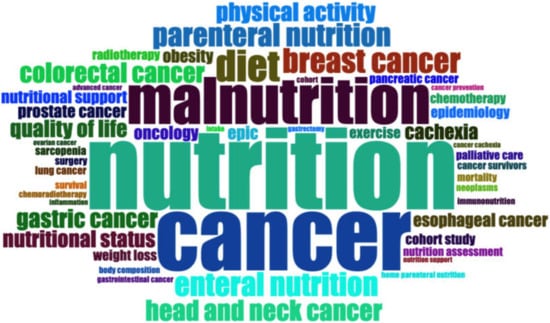
Figure 4.
The word-cloud analysis on nutrition and cancer from 2011 to 2021.
3.3. Journals
Of the 516 journals, the Nutrients journal of the Multidisciplinary Digital Publishing Institute was found to have the highest number of articles (70 articles); the second highest journal was the International Journal of Cancer (68 articles). Each journal had a different publisher, but the proposed aim and scope were similar, heavily focusing on generating evidence-based findings in nutrition-cancer research. The details are described in Table 4.

Table 4.
Top 10 most productive journals.
3.4. Country Collaboration
Although the majority of the author affiliations was in European countries, the corresponding authors from the United States have contributed the most articles (239 articles). The corresponding authors from China were ranked in second (170 articles). Despite the ranking, five European countries were ranked in the top 10 list (Table 5).

Table 5.
Top 10 corresponding authors’ countries.
A world collaboration map was generated to discover the world’s research. The blue color on the map represents the number of publications per country with intensity; the red lines indicate the extent of collaboration between the authors. It is notable that authors from Italy have vibrantly collaborated with authors from Germany, United Kingdom, France, and Spain (Table 6, Figure 5). The second most active authors were from United Kingdom; the authors collaborated with authors from Germany, France, and Spain.

Table 6.
Top 10 countries with the highest frequencies of collaboration.
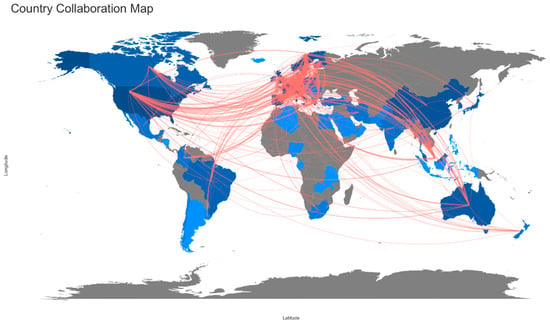
Figure 5.
World map of country collaboration.
4. Discussion
This bibliometric analysis on the topic of nutrition and cancer has provided profound findings to consider. First of all, the number of publications has been upward with the substantial growth identified since 2019. As more than 100 publications were increased since 2019, it can be expected to have more than 300 publications in 2022. The trend will continue to rise as cancer is more susceptible to aging population and is one of the leading causes of death in males and females aged 60 to 79 years [38].
Surprisingly, a majority of the top authors’ affiliations were located in Europe. This perhaps could be associated with the high prevalence of use of complementary and alternative medicine (CAM). Kemppainen et al. mentioned that 25.9% of the general population in Europe has used CAM modalities in 2017 [39]. The results can be seen oddly since there is a higher prevalence of using traditional medicine in Asian countries since the traditional medicine is embedded in health systems in Korea, Japan, and China [40]. This may be perhaps cancer patients are more inclined to use herbal medicines rather than nutrition [41].
With regard to the author keywords, malnutrition was the highest after the nutrition and cancer keywords. Even though nutritional status is regularly examined throughout the patients’ treatment, an accurate nutritional screening is critical. An acute nutritional evaluation ought to be performed at the time of each cancer diagnosis [42]. In addition, malnutrition and eating disorders are common features during and beyond cancer therapies so that continuous nutritional management can be the key for managing cancer [43].
From the analysis of the author keywords, breast cancer, head and neck cancer, colorectal cancer, and gastric cancer were within the top 10 list; however, it can be assumed that nutrition is well-applied to various types of cancer treatments from the results on the word cloud visualization. Other than the mentioned cancer types, lung cancer, pancreatic cancer, gastrointestinal cancer, and esophageal cancer were revealed. The reason is that nutrition influences key cellular and molecular processes that characterize cancer cells; therefore, good nutrition is especially important as it can change the illness and the course of treatments [44].
Regarding the analysis of country collaboration, it is highly one-sided since the promotion of nutrition for cancer is heavily practiced in European countries. Some countries from Asia and North America were identified; however, not enough collaboration occurred to provide in-depth research. A collaborative effort between Asian countries is highly recommended, as the Asian countries have been used herbal medicines for a long time. Furthermore, a collaboration with the African countries is much needed since the concept of nutrition therapies are not much promoted [45].
This study has a few limitations. First, using only the literature in English may have ignored vital insights from the literature in other languages. Considering only English publications, a few important articles in other languages may have been missed. Since a bibliometric analysis does not address specific research questions, narrow areas of the topic are not identified.
Despite the limitations, future research directions having broader exploratory research questions aimed at mapping keywords and finding gaps in the related existing knowledge and research are distinguishable using a bibliometric analysis. Hence, this bibliometric analysis contributed to a better understand of nutrition and cancer research in a clear way with the vast amount of literature with the key elements.
5. Conclusions
This bibliometric and visualized analysis of nutrition in cancer research revealed that the global trend of research regarding nutrition and cancer has gradually increased. As the number of publications has sparked since 2019, it is expected that the research output will increase in the near future. Based on the analysis of the word-cloud using the author keywords, research applying nutrition in various types of cancer could be effective. Research collaboration was noted worldwide; however, authors from European countries vibrantly worked together. Since the topic was set to be rather broad, further research should highlight in much narrower topics, indicating certain nutritional therapies and interventions with cancer patients. The findings of this study will be insightful for researchers and practitioners working in the field of nutrition and cancer, illuminating and suggesting future research directions for the betterment of cancer care, providing evidence-based solutions for healthcare professionals.
Author Contributions
Conceptualization, B.-Y.Y. and S.-Y.L.; methodology, B.-Y.Y.; software, B.-Y.Y.; validation, W.C., K.-R.B. and C.C.; formal analysis, B.-Y.Y.; investigation, W.C., K.-R.B. and C.C.; writing—original draft preparation, B.-Y.Y.; writing—review and editing, B.-Y.Y. and S.-Y.L.; visualization, B.-Y.Y.; supervision, C.C. and S.-G.K.; project administration, S.-G.K. All authors have read and agreed to the published version of the manuscript.
Funding
This research was funded by the National Research Foundation of Korea (NRF) grant funded by Korean government (MIST) (no.2020R1A5A2019413).
Institutional Review Board Statement
Not applicable.
Informed Consent Statement
Not applicable.
Data Availability Statement
The datasets used and/or analyzed during the current study are available from the first author upon reasonable request.
Conflicts of Interest
The authors declare no conflict of interest.
References
- Bianchi, V.E.; Herrera, P.F.; Laura, R. Effect of nutrition on neurodegenerative diseases. A systematic review. Nutr. Neurosci. 2021, 24, 810–834. [Google Scholar] [CrossRef]
- Kim, J.; Jeong, K.; Lee, S.; Seo, B.N.; Baek, Y. Low nutritional status links to the prevalence of pre-metabolic syndrome and its cluster in metabolically high-risk Korean adults: A cross-sectional study. Medicine 2021, 100, e25905. [Google Scholar] [CrossRef]
- Tsaousi, G.; Panidis, S.; Stavrou, G.; Tsouskas, J.; Panagiotou, D.; Kotzampassi, K. Prognostic indices of poor nutritional status and their impact on prolonged hospital stay in a Greek university hospital. BioMed Res. Int. 2014, 2014, 924270. [Google Scholar] [CrossRef]
- Raffaitin, C.; Lasseur, C.; Chauveau, P.; Barthe, N.; Gin, H.; Combe, C.; Rigalleau, V. Nutritional status in patients with diabetes and chronic kidney disease: A prospective study. Am. J. Clin. Nutr. 2007, 85, 96–101. [Google Scholar] [CrossRef]
- Marshall, K.M.; Loeliger, J.; Nolte, L.; Kelaart, A.; Kiss, N.K. Prevalence of malnutrition and impact on clinical outcomes in cancer services: A comparison of two time points. Clin. Nutr. 2019, 38, 644–651. [Google Scholar] [CrossRef]
- Muscaritoli, M.; Krznaric, Z.; Singer, P.; Barazzoni, R.; Cederholm, T.; Golay, A.; Van Gossum, A.; Kennedy, N.; Kreymann, G.; Laviano, A.; et al. Effectiveness and efficacy of nutritional therapy: A systematic review following Cochrane methodology. Clin. Nutr. 2017, 36, 939–957. [Google Scholar] [CrossRef]
- Pingili, S.; Ahmed, J.; Sujir, N.; Shenoy, N.; Ongole, R. Evaluation of Malnutrition and Quality of Life in Patients Treated for Oral and Oropharyngeal Cancer. Sci. World J. 2021, 2021, 9936715. [Google Scholar] [CrossRef]
- Kristensen, M.B.; Isenring, E.; Brown, B. Nutrition and swallowing therapy strategies for patients with head and neck cancer. Nutrition 2020, 69, 110548. [Google Scholar] [CrossRef]
- Song, M.; Zhang, X.; Meyerhardt, J.A.; Giovannucci, E.L.; Ogino, S.; Fuchs, C.S.; Chan, A.T. Marine omega-3 polyunsaturated fatty acid intake and survival after colorectal cancer diagnosis. Gut 2017, 66, 1790–1796. [Google Scholar] [CrossRef]
- Vashi, P.; Popiel, B.; Lammersfeld, C.; Gupta, D. Outcomes of systematic nutritional assessment and medical nutrition therapy in pancreatic cancer. Pancreas 2015, 44, 750–755. [Google Scholar] [CrossRef]
- Hebuterne, X.; Lemarie, E.; Michallet, M.; de Montreuil, C.B.; Schneider, S.M.; Goldwasser, F. Prevalence of malnutrition and current use of nutrition support in patients with cancer. J. Parenter. Enter. Nutr. 2014, 38, 196–204. [Google Scholar] [CrossRef]
- Caillet, P.; Liuu, E.; Raynaud Simon, A.; Bonnefoy, M.; Guerin, O.; Berrut, G.; Lesourd, B.; Jeandel, C.; Ferry, M.; Rolland, Y.; et al. Association between cachexia, chemotherapy and outcomes in older cancer patients: A systematic review. Clin. Nutr. 2017, 36, 1473–1482. [Google Scholar] [CrossRef]
- Pilleron, S.; Soto-Perez-de-Celis, E.; Vignat, J.; Ferlay, J.; Soerjomataram, I.; Bray, F.; Sarfati, D. Estimated global cancer incidence in the oldest adults in 2018 and projections to 2050. Int. J. Cancer 2021, 148, 601–608. [Google Scholar] [CrossRef]
- Zhang, X.; Pang, L.; Sharma, S.V.; Li, R.; Nyitray, A.G.; Edwards, B.J. Malnutrition and overall survival in older patients with cancer. Clin. Nutr. 2021, 40, 966–977. [Google Scholar] [CrossRef]
- Ravasco, P. Nurition in cancer patients. J. Clin. Med. 2019, 8, 1211. [Google Scholar] [CrossRef]
- Hariyanto, T.I.; Kurniawan, A. Appetite problem in cancer patients: Pathophysiology, diagnosis, and treatment. Cancer Treat. Res. Commun. 2021, 27, 100336. [Google Scholar] [CrossRef]
- Wang, X.S.; Zhao, F.; Fisch, M.J.; O’Mara, A.M.; Cella, D.; Mendoza, T.R.; Cleeland, C.S. Prevalence and characteristics of moderate to severe fatigue: A multicenter study in cancer patients and survivors. Cancer 2014, 120, 425–432. [Google Scholar] [CrossRef]
- Cotogni, P.; Pedrazzoli, P.; De Waele, E.; Aprile, G.; Farina, G.; Stragliotto, S.; De Lorenzo, F.; Caccialanza, R. Nutritional Therapy in Cancer Patients Receiving Chemoradiotherapy: Should We Need Stronger Recommendations to Act for Improving Outcomes? J. Cancer 2019, 10, 4318–4325. [Google Scholar] [CrossRef]
- De van der Schueren, M.A.E.; Laviano, A.; Blanchard, H.; Jourdan, M.; Arends, J.; Baracos, V.E. Systematic review and meta-analysis of the evidence for oral nutritional intervention on nutritional and clinical outcomes during chemo(radio)therapy: Current evidence and guidance for design of future trials. Ann. Oncol. 2018, 29, 1141–1153. [Google Scholar] [CrossRef]
- Arends, J.; Baracos, V.; Bertz, H.; Bozzetti, F.; Calder, P.C.; Deutz, N.E.P.; Erickson, N.; Laviano, A.; Lisanti, M.P.; Lobo, D.N.; et al. ESPEN expert group recommendations for action against cancer-related malnutrition. Clin. Nutr. 2017, 36, 1187–1196. [Google Scholar] [CrossRef]
- Donaldson, M.S. Nutrition and cancer: A review of the evidence for an anti-cancer diet. Nutr. J. 2004, 3, 19–31. [Google Scholar] [CrossRef]
- Mayne, S.T.; Playdon, M.C.; Rock, C.L. Diet, nutrition, and cancer: Past, present and future. Nat. Rev. Clin. Oncol. 2016, 13, 504–515. [Google Scholar] [CrossRef]
- Zhang, S.; Zhao, D.; Jia, W.; Wang, Y.; Liang, H.; Liu, L.; Wang, W.; Yu, Z.; Guo, F. A bibliometric analysis and review of recent researches on TRPM7. Channels 2020, 14, 203–215. [Google Scholar] [CrossRef]
- Doskaliuk, B.; Yatsyshyn, R.; Klishch, I.; Zimba, O. COVID-19 from a rheumatology perspective: Bibliometric and altmetric analysis. Rheumatol. Int. 2021, 41, 2091–2103. [Google Scholar] [CrossRef]
- Faruk, M.; Rahman, M.; Hasan, S. How digital marketing evolved over time: A bibliometric analysis on scopus database. Heliyon 2021, 7, e08603. [Google Scholar] [CrossRef]
- Akintunde, T.Y.; Chen, S.; Musa, T.H.; Amoo, F.O.; Adedeji, A.; Ibrahim, E.; Tassang, A.E.; Musa, I.H.; Musa, H.H. Tracking the progress in COVID-19 and vaccine safety research—A comprehensive bibliometric analysis of publications indexed in Scopus database. Hum. Vaccines Immunother. 2021, 17, 3887–3897. [Google Scholar] [CrossRef]
- Sweileh, W.M. Bibliometric analysis of peer-reviewed literature on antimicrobial stewardship from 1990 to 2019. Glob. Health 2021, 17, 1. [Google Scholar] [CrossRef]
- Reglero, C.; Reglero, G. Precision nutrition and cancer relapse prevention: A systematic literature review. Nutrients 2019, 11, 2799. [Google Scholar] [CrossRef]
- Baguley, B.J.; Bolam, K.A.; Wright, O.R.; Skinner, T.L. The effect of nutrition therapy and exercise on cancer-related fatigue and quality of life in men with prostate cancer: A systematic review. Nutrients 2017, 9, 1003. [Google Scholar] [CrossRef]
- Forbes, C.C.; Swan, F.; Greenley, S.L.; Lind, M.; Johnson, M.J. Physical activity and nutrition interventions for older adults with cancer: A systematic review. J. Cancer Surviv. 2020, 14, 689–711. [Google Scholar] [CrossRef]
- Bye, A.; Sandmael, J.A.; Stene, G.B.; Thorsen, L.; Balstad, T.R.; Solheim, T.S.; Pripp, A.H.; Oldervoll, L.M. Exercise and nutrition interventions in patients with head and neck cancer during curative treatment: A systematic review and meta-analysis. Nutrients 2020, 12, 3233. [Google Scholar] [CrossRef]
- Youn, B.-Y.; Song, H.J.; Yang, K.; Cheon, C.; Ko, Y.; Jang, B.-H.; Shin, Y.-C.; Ko, S.-G. Bibliometric analysis of integrative medicine studies from 2000 to 2019. Am. J. Chin. Med. 2021, 49, 829–841. [Google Scholar] [CrossRef]
- Chan, K.I.; Ignacio, K.H.; Omar, A.T.; Khu, K.J. Top 100 most cited neurologic and neurosurgical articles on COVID-19: A bibliometric analysis. World Neurosurg. 2022, 157, e137–e147. [Google Scholar] [CrossRef]
- Lastella, M.; Memon, A.R.; Vincent, G.E. Global research output on sleep research in athletes from 1966 to 2019: A bibliometric analysis. Clocks Sleep 2020, 2, 99–119. [Google Scholar] [CrossRef]
- Massimo, A.; Corrado, C. Bibliometrix: An R-tool for comprehensive science mapping analysis. J. Informetr. 2017, 11, 959–975. [Google Scholar]
- Yu, Y.; Li, Y.; Zhang, Z.; Gu, Z.; Zhong, H.; Zha, Q.; Yang, L.; Zhu, C.; Chen, E. A bibliometric analysis using VOSviewer of publications on COVID-19. Ann. Transl. Med. 2020, 8, 816–827. [Google Scholar] [CrossRef]
- Van Eck, N.J.; Waltman, L. Software survey: VOSviewer, a computer program for bibliometric mapping. Scientometrics 2010, 84, 523–538. [Google Scholar] [CrossRef]
- Fane, M.; Weeraratna, A.T. How the ageing microenvironment influences tumour progression. Nat. Rev. Cancer 2020, 20, 89–106. [Google Scholar] [CrossRef]
- Kemppainen, L.M.; Kemppainen, T.T.; Reippainen, J.A.; Salmenniemi, S.T.; Vuolanto, P.H. Use of complementary and alternative medicine in Europe: Health-related and sociodemographic determinants. Scand. J. Public Health 2018, 46, 448–455. [Google Scholar] [CrossRef]
- Park, H.-L.; Lee, H.-S.; Shin, B.-C.; Liu, J.-P.; Shang, Q.; Yamashita, H.; Lim, B. Traditional medicine in China, Korea, Japan: A brief introduction and comparison. Evid.-Based Complement. Altern. Med. 2012, 2012, 429103. [Google Scholar] [CrossRef]
- Asiimwe, J.B.; Nagendrappa, P.B.; Atukunda, E.C.; Kamatenesi, M.M.; Nambozi, G.; Tolo, C.U.; Ogwang, P.E.; Sarki, A.M. Prevalence of the use of herbal medicines among patients with cancer: A systematic review and meta-analysis. Evid.-Based Complement. Altern. Med. 2012, 2021, 9963038. [Google Scholar] [CrossRef] [PubMed]
- Castillo-Martínez, L.; Castro-Eguiluz, D.; Copca-Mendoza, E.T.; Pérez-Camargo, D.A.; Reyes-Torres, C.A.; Ávila, E.A.; López-Córdova, G.; Fuentes-Hernández, M.R.; Cetina-Pérez, L.; Milke-García, M.D.P. Nutritional Assessment Tools for the Identification of Malnutrition and Nutritional Risk Associated with Cancer Treatment. Rev. Investig. Clin. 2018, 70, 121–125. [Google Scholar] [CrossRef] [PubMed]
- Greenlee, H.; Santiago-Torres, M.; McMillen, K.K.; Ueland, K.; Haase, A.M. Helping Patients Eat Better During and Beyond Cancer Treatment: Continued Nutrition Management throughout Care to Address Diet, Malnutrition, and Obesity in Cancer. Cancer J. 2019, 25, 320–328. [Google Scholar] [CrossRef] [PubMed]
- Wiseman, M.J. Nutrition and cancer: Prevention and survival. Br. J. Nutr. 2019, 122, 481–487. [Google Scholar] [CrossRef]
- World Cancer Research Fund International Home Page. Available online: https://www.wcrf.org/nutrition-and-breast-cancer-in-south-africa/ (accessed on 28 January 2022).
Publisher’s Note: MDPI stays neutral with regard to jurisdictional claims in published maps and institutional affiliations. |
© 2022 by the authors. Licensee MDPI, Basel, Switzerland. This article is an open access article distributed under the terms and conditions of the Creative Commons Attribution (CC BY) license (https://creativecommons.org/licenses/by/4.0/).